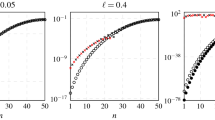Abstract
Numerical integration is a classical problem emerging in many fields of science. Multivariate integration cannot be approached with classical methods due to the exponential growth of the number of quadrature nodes. We propose a method to overcome this problem. Tensor-train decomposition of a tensor approximating the integrand is constructed and used to evaluate a multivariate quadrature formula. We show how to deal with singularities in the integration domain and conduct theoretical analysis of the integration accuracy. The reference open-source implementation is provided.

Similar content being viewed by others
Notes
They appear as ingredients in quantum chromodynamics (QCD) calculations and in supersymmetric \(N=4\) Yang–Mills theory within perturbation theory. These Feynman integrals are found in many important functions of these theories, in particular, various anomalous dimensions and form factors.
REFERENCES
C. Bogner and S. Weinzierl, ‘‘Resolution of singularities for multi-loop integrals,’’ Comput. Phys. Commun. 178, 596–610 (2008). https://doi.org/10.1016/j.cpc.2007.11.012
R. Piessens, E. de Doncker, C. Uberhuber, and D. Kahaner, Quadpack: A Subroutine Package for Automatic Integration (Springer, Berlin, 1983). https://doi.org/10.1007/978-3-642-61786-7
G. P. Lepage, ‘‘A new algorithm for adaptive multidimensional integration,’’ J. Comput. Phys. 27, 192–203 (1978). https://doi.org/10.1016/0021-9991(78)90004-9
G. P. Lepage, ‘‘VEGAS: An adaptive multi-dimensional integration routine,’’ Tech. Report No. CLNS-80/447 (Newman Labor. Nucl. Studies, Cornell Univ., Ithaca, NY, 1980).
W. H. Press and G. R. Farrar, ‘‘Recursive stratified sampling for multidimensional Monte Carlo integration,’’ Comput. Phys. 4, 190–195 (1990). https://doi.org/10.1063/1.4822899
R. Schürer, ‘‘Adaptive quasi-Monte Carlo integration based on MISER and VEGAS,’’ in Monte Carlo and Quasi-Monte Carlo Methods 2002, Ed. by H. Niederreiter (Springer, Berlin, 2004). https://doi.org/10.1007/978-3-642-18743-8_25
J. Berntsen, T. Espelid, and A. Genz, ‘‘An adaptive algorithm for the approximate calculation of multiple integrals,’’ ACM Trans. Math. Software 17, 437–451 (1991). https://doi.org/10.1145/210232.210233
J. Dick, F. Y. Kuo, and I. H. Sloan, ‘‘High-dimensional integration: The quasi-Monte Carlo way,’’ Acta Numer. 22, 133–288 (2013).
S. Borowka, G. Heinrich, S. Jahn, S. P. Jones, M. Kerner, J. Schlenk, and T. Zirke, ‘‘pySecDec: A toolbox for the numerical evaluation of multi-scale integrals,’’ Comput. Phys. Commun. 222, 313–326 (2018). https://doi.org/10.1016/j.cpc.2017.09.015
S. Borowka, G. Heinrich, S. Jahn, S. P. Jones, M. Kerner, and J. Schlenk, ‘‘A GPU compatible quasi-Monte Carlo integrator interfaced to pySecDec,’’ Comput. Phys. Commun. 240, 120–137 (2019). https://doi.org/10.1016/j.cpc.2019.02.015
I. V. Oseledets and E. E. Tyrtyshnikov, ‘‘TT-cross approximation for multidimensional arrays,’’ Linear Algebra Appl. 432, 70–88 (2010). https://doi.org/10.1016/j.laa.2009.07.024
S. Dolgov and D. Savostyanov, ‘‘Parallel cross interpolation for high-precision calculation of high-dimensional integrals,’’ Comput. Phys. Commun. 246, 106869 (2020). https://doi.org/10.1016/j.cpc.2019.106869
I. V. Oseledets, ‘‘Tensor-train decomposition,’’ SIAM J. Sci. Comput. 33, 2295–2317 (2011). https://doi.org/10.1137/090752286
A. V. Smirnov, ‘‘FIESTA 4: Optimized Feynman integral calculations with GPU support,’’ Comput. Phys. Comm. 204, 189–199 (2016). https://doi.org/10.1016/j.cpc.2016.03.013
D. Kahaner, C. Moler, and S. Nash, Numerical Methods and Software (Prentice-Hall, Englewood Cliffs, CA, 1989).
E. E. Tyrtyshnikov, A Brief Introduction to Numerical Analysis (Springer Science, New York, 2012).
M. H. Protter and B. Charles, Jr., Intermediate Calculus (Springer Science, New York, 2012).
S. A. Goreinov and E. E. Tyrtyshnikov, ‘‘The maximal-volume concept in approximation by low-rank matrices,’’ Contemp. Math. 208, 47–52 (2001)
S. A. Goreinov, N. L. Zamarashkin, and E. E. Tyrtyshnikov, ‘‘Pseudo-skeleton approximations by matrices of maximal volume,’’ Math. Notes 62, 515–519 (1997). https://doi.org/10.1007/bf02358985
A. Civril and M. Magdon-Ismail, ‘‘On selecting a maximum volume sub-matrix of a matrix and related problems,’’ Theor. Comput. Sci. 410, 4801–4811 (2009). https://doi.org/10.1016/j.tcs.2009.06.018
M. Bebendorf, ‘‘Approximation of boundary element matrices,’’ Numer. Math. 86, 565–589 (2000). https://doi.org/10.1007/PL00005410
E. E. Tyrtyshnikov, ‘‘Incomplete cross approximation in the mosaic-skeleton method,’’ Computing 64, 367–380 (2000). https://doi.org/10.1007/s006070070031
S. A. Goreinov, I. V. Oseledets, D. V. Savostyanov, E. E Tyrtyshnikov, and N. L. Zamarashkin, ‘‘How to find a good submatrix,’’ in Matrix Methods: Theory, Algorithms and Applications (World Scientific, Singapore, 2010), pp. 247–256. https://doi.org/10.1142/9789812836021_0015
S. M. Kirkup, J. Yazdani, and G. Papazafeiropoulos, ‘‘Quadrature rules for functions with a mid-point logarithmic singularity in the boundary element method based on the \(x=t^{p}\) substitution,’’ Am. J. Comput. Math. 09, 282–301 (2019). https://doi.org/10.4236/ajcm.2019.94021
M. Mori and M. Sugihara, ‘‘The double-exponential transformation in numerical analysis,’’ J. Comput. Appl. Math., 287–296 (2001). https://doi.org/10.1016/S0377-0427(00)00501-X
T. Hahn, ‘‘Cuba — a library for multidimensional numerical integration,’’ Comput. Phys. Commun. 168, 78–95 (2005). https://doi.org/10.1016/j.cpc.2005.01.010
Funding
The work is supported by Russian Ministry of Science and Higher Education, agreement no. 075-15-2019-1621.
Author information
Authors and Affiliations
Corresponding authors
Additional information
(Submitted by V. V. Voevodin)
Rights and permissions
About this article
Cite this article
Vysotsky, L.I., Smirnov, A.V. & Tyrtyshnikov, E.E. Tensor-Train Numerical Integration of Multivariate Functions with Singularities. Lobachevskii J Math 42, 1608–1621 (2021). https://doi.org/10.1134/S1995080221070258
Received:
Revised:
Accepted:
Published:
Issue Date:
DOI: https://doi.org/10.1134/S1995080221070258




